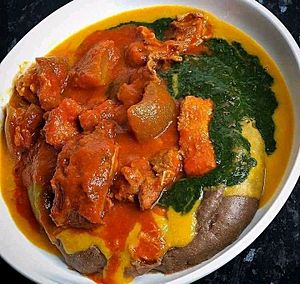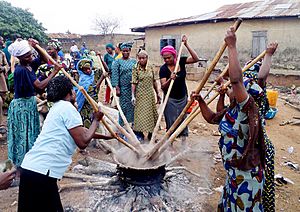Amala (food) facts for kids
Àmàlà is a local indigenous Yoruba food, native to the Yoruba ethnic group of Southwestern Nigeria. It is made out of yam and/or cassava flour, or unripe plantain flour. Tubers of yams are peeled, sliced, cleaned, dried and then blended into flour. It is also called èlùbọ́. Yams are white in colour but turn brown when dried which gives àmàlà its colour. It is a popular side dish served with ewédú and gbẹ̀gìrì (black-eyed beans soup), but is also served with a variety of other ọbẹ (soups), such as ẹ̀fọ́, ilá, and or ogbono.
Contents
Types
There are three types of àmàlà: àmàlà isu, àmàlà láfún and "amala ogede".
Yam flour (àmàlà isu)
This is the most common type of àmàlà, which is derived from yam. The particular yam species best for preparing àmàlà is Dioscorea cayenensis (Ikoro) because of its high starch content. Yam, the common name for species in the genus Dioscorea, grows in Africa, Asia, the Caribbean, Oceania, and Latin America. However, 95% of it is cultivated and harvested in West Africa. Yam is consumed in many different forms including boiled, roasted, baked, fried and conversion into flours. The perishability nature of yam due to its high moisture content suggests the need to process it into less perishable products such as yam flour through drying process. The flour can be reconstituted with hot water to form a paste or gel called Kokonte in Ghana and in Togo, and "Amala" in Nigeria. Àmàlà isu is made of dried yam. This gives it a black/brownish colour when added to boiling water. Amala is rich in carbohydrates owning to the fact that yam is an important source of carbohydrate for many people of the Sub Saharan region especially in the yam zone of west Africa.
Cassava flour (àmàlà láfún)
The second type is àmàlà láfún, made from cassava flour. Dried cassava flour is known as “lafun” in Nigeria and "konkonte" in Ghana.
Cassava is a woody shrub of the Euphorbiaceae (spurge) family. Cassava and yam are the most important source of food carbohydrate in Nigeria. Nigeria is the world's largest producer of cassava. Cassava flour, when used as a dry powder makes àmàlà láfún. Fermented and flaky, it is called Garri, another common dish, most often eaten by the Ijebu people.
Plantain flour (Amala ogede)
Another type of Amala is elubo ogede (which is usually lighter in color). The low carbohydrate level in plantain flour makes it a good diet for people diagnosed of diabetics and others who need a low-carbohydrate food. Unripe plantain is peeled, dried, and grated into boiling water to become amala ogede, light brown in colour when cooked.
Preparation
Amala is made from yam peels which have been dried and ground to flour, and then boiled in water to a dough.
Soups
Àmàlà can be eaten with various soups:
- Egusi: soup made of thickened melon seeds and leaf vegetables
- Ewedu soup: made from cooked and grated Corchorus leaves with or without a small quantity of egusi and/or locust beans.
- Okro soup: made from okra
- Efo riro: made from vegetables and a mixture of meat, fish, etc.
- Ogbono soup: made from ground ogbono seeds and a mixture of stock fish and locust beans added as garnish
- Gbegiri soup, made from dried beans
See also
 In Spanish: Àmàlà para niños
In Spanish: Àmàlà para niños




